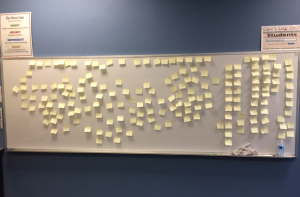Guest Blogger Christian Kowalski
In every creative process, there needs to be a level of organization involved. Not everyone is capable of threading together thoughts in a stream-of-consciousness way. Fortunately, this CUPID Studio class had the structures in place to effectively express many ideas but also keep the brainstorming process organized so as to avoid confusion.
Our class project was to re-imagine the English newsletter, The Back Cover, to me more engaging ans accessible to a wider audience. The first two weeks of class involved each student being challenged to write as many ideas regarding the newsletter they had on sticky notes within a limited time. From there, students were encouraged to share their suggestions with the class. The writing compounded with the group discussion offered a more dynamic learning environment as opposed to brainstorming in one mode. The quick succession of sticky note to sticky note offered our class the opportunity to pinpoint what worked and didn’t work. From there we grouped the sticky notes in sub-sections depending where they fitted within the newsletter redesign.
 The brainstorming sessions our class underwent proved to be the bedrock of what made the first half of this semester successful. Other organizations I’ve been a part also have had brainstorming ideas for topics such as fundraising, events, and grants, but none of them had been executed with the effectiveness of CUPID. Our class is a small group with a diverse array of experience within Professional Writing and Rhetoric studies. The sticky note sessions allowed for every individual to make their mark. Some students were lightning quick with posting sticky notes. Their minds were like whips lashing every note onto the board until their arms got tired. Personally, it took me a bit of time to fully flesh out sticky note ideas, but as a writing strategy, it was effective in getting our class engaged.
The brainstorming sessions our class underwent proved to be the bedrock of what made the first half of this semester successful. Other organizations I’ve been a part also have had brainstorming ideas for topics such as fundraising, events, and grants, but none of them had been executed with the effectiveness of CUPID. Our class is a small group with a diverse array of experience within Professional Writing and Rhetoric studies. The sticky note sessions allowed for every individual to make their mark. Some students were lightning quick with posting sticky notes. Their minds were like whips lashing every note onto the board until their arms got tired. Personally, it took me a bit of time to fully flesh out sticky note ideas, but as a writing strategy, it was effective in getting our class engaged.
The strategic brainstorming coordinated for the CUPID Studio is what provided us the opportunity to create a fully fleshed out guide for the English newsletter. Each individual member contributed thorough suggestions and offered substantive feedback for other members of the class. Brainstorming provided a collaborative experience to share insights and grow from the knowledge of our colleagues. These strategies employed were what allowed our class to move through the creative process so fluidly.

 Follow
Follow